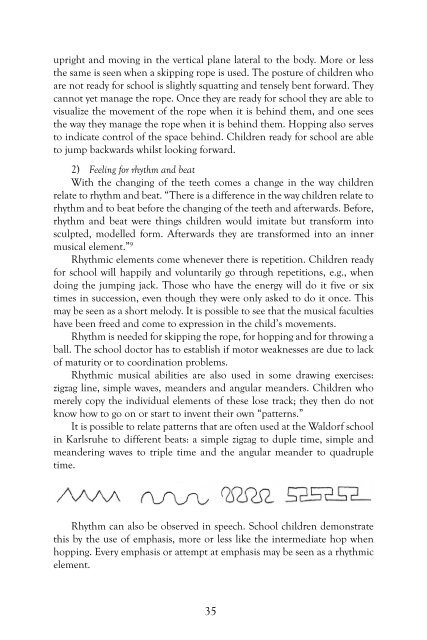When Healing Becomes Educating, Vol. 6 - Waldorf Research Institute
When Healing Becomes Educating, Vol. 6 - Waldorf Research Institute
When Healing Becomes Educating, Vol. 6 - Waldorf Research Institute
You also want an ePaper? Increase the reach of your titles
YUMPU automatically turns print PDFs into web optimized ePapers that Google loves.
upright and moving in the vertical plane lateral to the body. More or less<br />
the same is seen when a skipping rope is used. The posture of children who<br />
are not ready for school is slightly squatting and tensely bent forward. They<br />
cannot yet manage the rope. Once they are ready for school they are able to<br />
visualize the movement of the rope when it is behind them, and one sees<br />
the way they manage the rope when it is behind them. Hopping also serves<br />
to indicate control of the space behind. Children ready for school are able<br />
to jump backwards whilst looking forward.<br />
2) Feeling for rhythm and beat<br />
With the changing of the teeth comes a change in the way children<br />
relate to rhythm and beat. “There is a difference in the way children relate to<br />
rhythm and to beat before the changing of the teeth and afterwards. Before,<br />
rhythm and beat were things children would imitate but transform into<br />
sculpted, modelled form. Afterwards they are transformed into an inner<br />
musical element.” 9<br />
Rhythmic elements come whenever there is repetition. Children ready<br />
for school will happily and voluntarily go through repetitions, e.g., when<br />
doing the jumping jack. Those who have the energy will do it five or six<br />
times in succession, even though they were only asked to do it once. This<br />
may be seen as a short melody. It is possible to see that the musical faculties<br />
have been freed and come to expression in the child’s movements.<br />
Rhythm is needed for skipping the rope, for hopping and for throwing a<br />
ball. The school doctor has to establish if motor weaknesses are due to lack<br />
of maturity or to coordination problems.<br />
Rhythmic musical abilities are also used in some drawing exercises:<br />
zigzag line, simple waves, meanders and angular meanders. Children who<br />
merely copy the individual elements of these lose track; they then do not<br />
know how to go on or start to invent their own “patterns.”<br />
It is possible to relate patterns that are often used at the <strong>Waldorf</strong> school<br />
in Karlsruhe to different beats: a simple zigzag to duple time, simple and<br />
meandering waves to triple time and the angular meander to quadruple<br />
time.<br />
Rhythm can also be observed in speech. School children demonstrate<br />
this by the use of emphasis, more or less like the intermediate hop when<br />
hopping. Every emphasis or attempt at emphasis may be seen as a rhythmic<br />
element.<br />
35

















